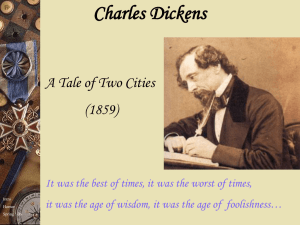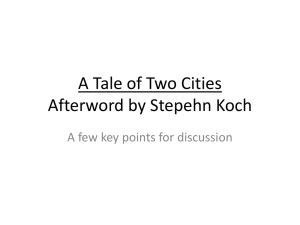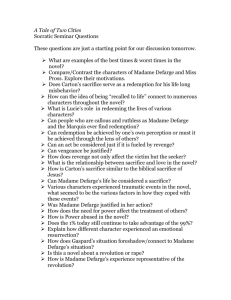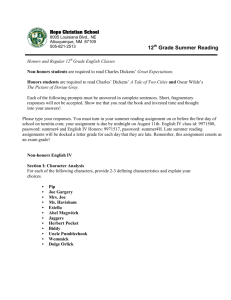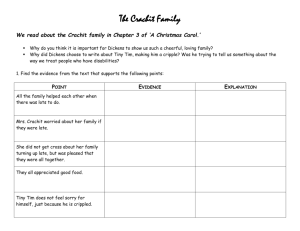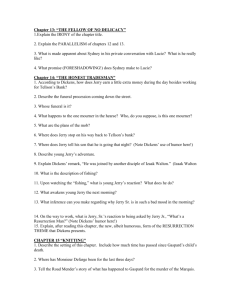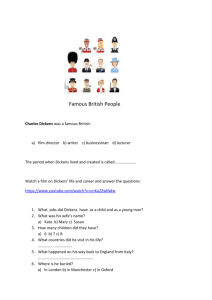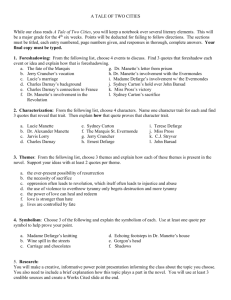Symbolism in Dickens' A Tale of Two Cities
advertisement
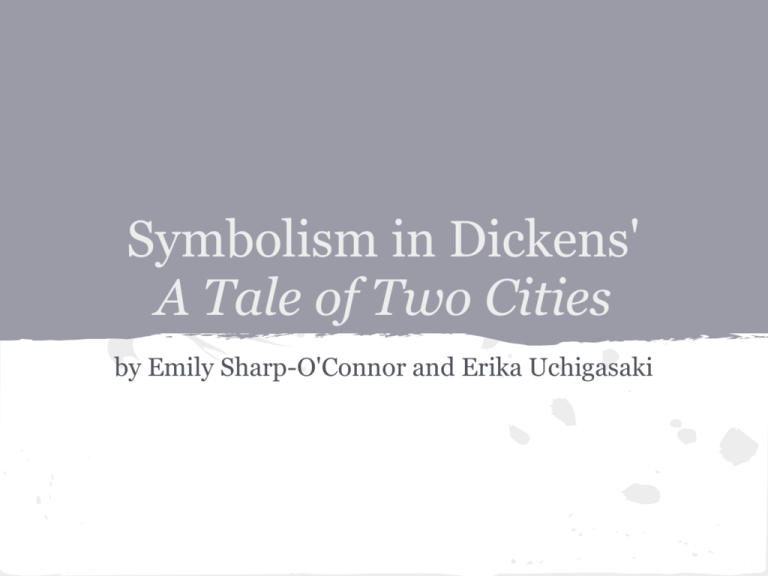
Symbolism in Dickens' A Tale of Two Cities by Emily Sharp-O'Connor and Erika Uchigasaki Overview Throughout A Tale of Two Cities, Dickens uses symbolism to deepen the understanding of the reader, by showing different traits, feelings, and abstract concepts through objects, the weather and even characters. This allows him to show more about the characters and story in a more sophisticated way than simply stating the information. The main symbols Dickens uses are: knitting/thread, the characterization of Madame Defarge, wine, and stone. Knitting/Thread Quotes 1. 2. 3. 4. "It would be easier... to erase himself from existence, than to erase one letter of his name or his crimes from the knitted register of Madame Defarge" (166). "Ever busily winding the golden thread that bound them all together... Lucie heard in the echoes of years none but friendly and soothing sounds" (201). "...stopping in her work for the first time, and pointing her knitting-needle at little Lucie as if it was the finger of Fate" (259). Also important to note: When Dickens introduces the reader to Dr. Manette, he is sewing a lady's shoe, and carrying his wife's hairs in a rag around his neck on a thread. By doing so, he remains connected to the world outside, and his real life. Knitting/Thread Analysis The Fates: Dickens makes many references to this meaning, as seen in Quotes 1 and 3, as well as his characterization of women in general. Consider which of the three Fates (weaving, measuring, spinning) each female character would symbolize and why. Life/Death: Madame Defarge's knitting means literal death for many. However, as Lucie (the Golden Thread) takes care of her father, husband, and child, one could also argue that thread represents life. In the case of Dr. Manette, one could argue both sides. When he makes shoes, he is completely oblivious to the world around him. However making shoes allowed him to survive and have a purpose in prison, and Lucie as the Golden Thread is what keeps him alive. In the case of Dr. Manette, do you think thread represents life or death, and why? Control: Regardless of the fact that women were seen as inferior in France during this time period, Monsieur Defarge looks to his wife for help. The names in her knitted registry give her control over those she chooses to have executed, her husband and those who respect him. Does Madame Defarge remind you of a character in another piece of literature? Who and why? Madame Defarge Quotes 1. 2. 3. "The shadow attendant on Madame Defarge and her party seemed then to fall, threatening and dark, on both the mother and the child" (259). " 'See!' cried madame, pointing with her knife. 'See the old villain bound with ropes. That was well done to tie a bunch of grass upon his back. Ha, ha! That was well done. Let him eat it now!' " (215). " 'But when it is ready, it takes place, and grinds to pieces everything before it. In the meantime, it is always preparing, though it is not seen or heard. That is your consolation. Keep it.' She tied a knot with flashing eyes, as if it throttled a foe... 'My brave wife,' returned Defarge, standing before her with his head a little bent, and his hands clasped at his back, like a docile and attentive pupil before his catechist, 'I do not question all this' " (172). Madame Defarge Analysis Shadow/Darkness: Dickens makes it obvious to us that Madame Defarge is not a good character. She is motivated by hatred and the desire for revenge, and causes the deaths of many people in the name of the revolution, even when they aren't at fault for the misdeeds of the aristocracy. In many cases, she is characterized by a shadow. As her character causes so much violence, why do you think Dickens chose the symbolism of a shadow rather than a bloodier image? Strength: Madame Defarge acts in complete opposition to Lucie Manette. If Lucie is light, she is shadow, and if Lucie is motivated by love, Madame Defarge is motivated by hate. The two symbols used most commonly to represent these two women are knitting and thread. Obviously, a single thread is weaker than a piece of knitted fabric. Consider whether Dickens means this as a commentary on the strength of these two characters, and whether or not you agree that Madame Defarge is stronger than Lucie. Wine Quotes 1. 2. 3. 4. "Those who had been greedy with the staves of the cask, had acquired a tigerish smear about the mouth..." (28). "...one tall joker...scrawled upon a wall with his finger dipped in muddy wine-lees - BLOOD. The time was to come, when that wine too would be spilled on the street-stone, and the stain of it would be red upon many there" (28). Note the similarities between the scene with the spilled wine and the scene later with the guillotine. In both scenes the people are happy about the events that have occurred, although they are vastly different. Also note that the Defarges own a wineshop where they plot to kill those who they feel deserve to die. Wine Analysis Blood: The scene in which the wine spills in the streets foreshadows the blood that will spill from the guillotine, and the happiness with which that will also be received. Also note that the people who drank the wine with great thirst are the same people that become thirsty for the blood of the aristocrats. Their poverty drives them to both drink wine from the muddy ground and kill in hopes of gaining equality. Revolution: If Dickens uses wine to symbolize blood, then it could also be said that wine symbolizes the revolution. As wine cost money, the lower classes had to drink it diluted in order to afford it. This represents what was wrong with a system that allowed such a huge disparity in wealth. However, the revolution also eventually went too far, culminating in the Reign of Terror. The same mentality that drives the dance around the guillotine later in the novel is glimpsed during the scene with the wine. What might Dickens be implying about revolution? The French People: When one thinks of France, one often pictures drinking wine with meals. Thus, Dickens could be using wine not only to symbolize blood, but perhaps even the lifeblood of the French people. Stone Quotes 1. 2. 3. "It was a heavy mass of building, the chateau of Monsieur the Marquis, with large stone courtyard before it, and two stone sweeps of staircase meeting in a stone terrace before the principal door. A stoney business altogether, with heavy stone balustrades and stone urns and stone flowers and stone faces of men" (114). "...added the one stone face wanting; the stone face for which it had waited through about two hundred years. It lay back on the pillow of Monsieur the Marquis. It was like a fine mask, suddenly startled, made angry, and petrified. Driven into the heart of the stone figure attached to it was a knife" (124-125). "People who could lay hold of nothing else, set themselves with bleeding hands to force stones and bricks out of their places in walls" (206). Stone Analysis Aristocracy: Stone is both durable and rigid, and during this time period, so was the aristocracy is Europe. For example, Dickens compares the Marquis, especially after his death, to his chateau, as both are portrayed as being made of stone. Additionally, we see stone as being cold and inhuman, as a cruel person can be described as stone-hearted. By comparing the aristocracy to the stone buildings they live in, what is Dickens trying to say about them as people and as leaders? Control/Power: Architecture was important during this time period. From castles to slums, where a person lived and worked reflected their social status. Thus, the stone buildings of the aristocracy show their absolute power over France and England. This same idea can also be seen in the Bastille, which originally showed the aristocracy's power. However, when it was torn down, it quickly became a symbol of the strength of the rebellion. What other symbols does Dickens use to show the difference in power between the peasants and the aristocracy? Guiding Questions 1. Dickens uses many symbols in this novel. If only one 2. 3. could be included, which do you think is the most integral to the story and why? (Consider which symbol has the most far-reaching implications.) Although Dickens uses a great deal of symbolism when dealing with some characters, such as Madame Defarge, he uses very little with others, such as Charles Darnay. Why do you think he chooses to do this? We've discussed what each symbol might mean in terms of Dickens' novel. What might he be implying they represent in terms of the French Revolution as a whole?
